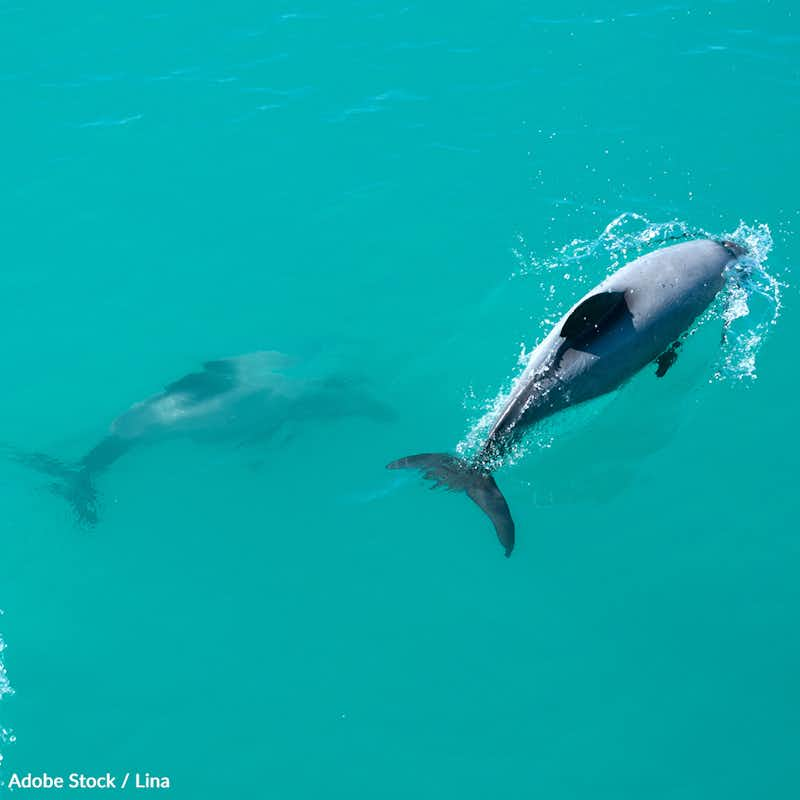Save New Zealand's Dolphins from Extinction
14,054 signatures toward our 30,000 Goal
Sponsor: The Animal Rescue Site
Hector's and Māui dolphin populations are dwindling. Help us tell New Zealand to ban mining operations in the critical habitat these mammals need to survive.

Hector’s dolphins are the smallest dolphin species in the world1 and only around 10,000 them remain alive in the wild, off the shores of the South Island of New Zealand2.
These dolphins stick to a territorial range of just over 32 miles, rarely venturing away from home3.
Within the population of Hector's dolphins, Māui dolphins are an even more rare subspecies with larger skulls and a longer, wider rostrum. There are only about 55 Māui dolphins left today4.
While Hector's dolphins are endangered and the the Māui dolphins critically endangered, not enough is being done to save these animals from extinction.
Gillnets used in fishing pose the biggest threat to the Hector's and Māui dolphins. These nets float vertically through the water to catch large quantities of fish, but also trap seabirds and other marine life as "bycatch5."
Close to 100,000 cetaceans – mainly dolphins – were caught in commercial gill nets as by-catch in 2018, a number that has since only decreased due to the depleted fish population.
New Zealand, as one of just two countries to reject the IUCN World Conservation Congress‘ motion to stop the extinction of rare dolphins and porpoises6, may have sealed the fate for these dolphins by opening up the Māui dolphin sanctuary to mining exploration, a decision that the Department of Conservation slammed for its potentially devastating effects on marine life in the area7.
Sign the petition and help us tell New Zealand’s Prime Minister to protect Hector’s and Māui dolphins before it’s too late!
- New Zealand Department of Conservation, "Facts about Hector’s and Māui dolphin."
- National Oceanic and Atmospheric Administration (8 September 2022), "Hector’s Dolphin."
- Akaroa Dolphins (2022), "Hector's Dolphin Facts."
- New Zealand Department of Conservation, "Facts about Hector’s and Māui dolphin."
- The Guardian (2 March 2020), "More than 80% of Indian Ocean dolphins may have been killed by commercial fishing, study finds."
- Bhanu Sridharan, (11 May 2020), "Study suggests tuna gillnet fisheries deadly for dolphins, but evidence unconvincing."
- World Wide Fund For Nature (21 September 2012), "NZ govt fails Maui’s dolphins on global stage."
- Estelle Rayburn, One Green Planet (2018), "There Are Only 55 Maui’s Dolphins Left but the New Zealand Government Just Opened Their Marine Sanctuary to Oil Mining."
The Petition:
To the Government and Department of Conservation of New Zealand,
There are only around 10,000 Hector's dolphins yet alive around the coasts of New Zealand's south island, and the population is dwindling fast. Further, there are only a few dozen Māui dolphins, a rare subspecies of the Hector's dolphin.
These species are threatened primarily by gillnets left behind by the fishing industry. However, mining operations, which New Zealand previously opened up in the Māui dolphin sanctuary, are pushing the dolphins even closer toward extinction.
It is a sad fact that New Zealand was one of just two countries to reject the IUCN World Conservation Congress‘ motion to stop the extinction of rare dolphins and porpoises.
If action is not taken soon, the Hector's and Māui dolphins may be lost forever.
I implore you to take a stand for these species and ban mining operations around the coasts of New Zealand's south island where the Hector's and Māui dolphins make their homes. Only with your leadership and greater protections will these species have a chance to survive and thrive.
Sincerely,